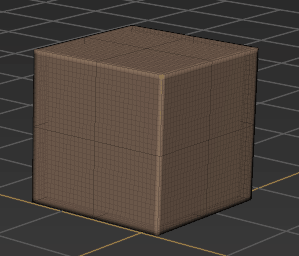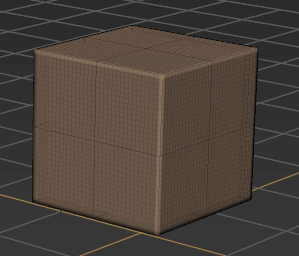The following describes the properties for the items that appear on the Paint Tools tray.
General
- Color
-
Displays the current color for the Paint Brush. Click the color tile to display the Color Chooser window and modify the color assigned to the Paint Brush.
- Affect
-
Specific to the Dodge and Burn tools. The presets let you bias the lightening (Dodge) or darkening (Burn) effect that occurs within the specified tonal range in the areas you stroke:
Note:Repeated strokes of the tool in the same area of an image build up the effect.
- Midtones
-
Affects the mid-tones (gray value range) on the texture image.
- Highlights
-
Affects the light gray to white values on the texture image.
- Shadows
-
Affects the darker gray to black tones on the texture image.
- All
-
Affects all tones on the texture image.
- Exposure
-
Specific to the Dodge and Burn tools. Controls the amount of lightening or darkening that occurs on the affected pixels for each stroke of the brush depending on the Affect setting.
- Blur Strength
-
Specific to the Blur tool. Determines the size of the circular area (in pixels) that is sampled to determine the amount of blur. The larger the radius, the greater the amount of blur. See Blur detail in painted textures.
- Contrast
-
Specific to the Contrast brush. Controls the difference between light and dark pixels. A positive value increases the contrast, negative values reduce it. The range is -10 to 10, default is 1.
- Amount
-
Specific to the Sponge brush. Increases or decreases the color saturation for pixels in an image as you stroke. A positive value decreases pixel color saturation, while a negative value increases it. The range is -1 to 1, default is 1.
- Hue Shift
-
Specific to the Hue Shift brush. Specifies the amount in degrees to shift hue values around the color ring relative to their current value. For example, a Hue Shift setting of 90 degrees shifts a red pixel hue to green (based on a counter-clockwise direction around the color ring). You can enter positive or negative values ranging between 1 to 180 degrees and also use the Color Chooser for reference. See Using the Color Chooser.
- Size
-
Sets the radius of the tool. Hotkeys: B + drag .
- Strength
-
Determines how much the tool applies with each stroke. Hotkey: M + drag or press ; (to reduce strength) and ' (to increase strength).
- Mirror
-
Reflects a stroke from one side of a model to the other, along the specified axis.
- Off
-
Strokes are not reflected.
- X
-
Reflects strokes across the world space X-axis.
- Y
-
Reflects strokes across the world space Y-axis.
- Z
-
Reflects strokes across the world space Z-axis.
- Local X
-
Reflects strokes across the local space X-axis.
- Local Y
-
Reflects strokes across the local space Y-axis.
- Local Z
-
Reflects strokes across the local space Z-axis.
- Use Stamp Image
-
Turns on the selected stamp for the tool. Stamps modify the strength of the paint brush according to the gray scale values in the stamp image. The darker the overall values the lower the strength of the tool. Not all paint brushes work with stamps.
- Stamp Offset
-
Lets you adjust the depth of a stamp imprint on a model's surface.


Stamp offset default versus offset set to 5.00
The default value is 0.00, which means that black areas of the stamp image make no surface impression, and the deformation strength increases until it reaches white. A Stamp Offset value of 0.50 means that black areas of the stamp image indent the model's surface with -50% deformation, continuing until it reaches a +50% elevation in the white areas.
- Sample
- Provides options for the Eyedropper brush to pick color from all paint layers or only from the current, active layer. By default, the All Layers option is selected.
- Flood Paint Layer
-
Floods the entire paint layer or layer mask with color, including all texture tiles and ignoring any stamps or stencils applied to the tool. See also Flood paint.
- Flood From Camera
-
Floods all parts of the texture map that are visible to the camera with color. (Not available for Clone, Blur, and Dry Brush tools.)
- Reset
-
Resets the tool properties to default values.
Advanced
- Remember Size
-
Preserves the size of the tool after use. When off, the brush inherits the size of the previously used brush.
- Orient To Surface
-
Orients the tool cursor display (in the 3D View) along the normal of the face under the center of the cursor ring. Influences cursor display only, does not influence the effect of the brush on the surface.
Pen Pressure
- Min Size
-
Specifies how small the tool is when the lightest pressure is applied to the pen, expressed as a percentage of the tool’s Size property. For example, a Min Size of 100 indicates there is no size variance, regardless of the pressure applied.
- Min Strength
-
Specifies how weak the tool strength is when the lightest pressure is applied to the pen, expressed as a percentage of the primary tool Strength value. For example, a Min Strength of 100 indicates there is no strength variance, regardless of the pressure applied.
- Disable Pure Color Filter
- Turning on this option enables you to paint stroke without the texture filter. This feature is available for paint and pencil brushes, and is useful for the Maya xGen feature.
- Gamma Correct Blending
- Turning on this option blends the texture painting before performing gamma correction.
For example, if you paint green over red with this option disabled (the default), dark edges appear wherever the colors overlap. When this option is active, Mudbox accounts for the actual paint color values, rather than averaging them. This addresses the issue of dark areas appearing between colors that overlap.
This setting is on (gamma-corrected) by default.
